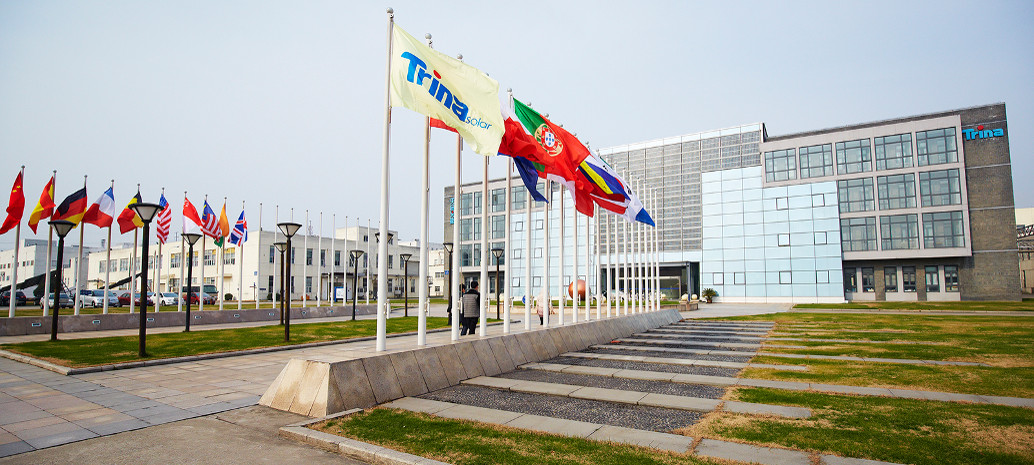Trina Solar, a module manufacturer with an in-house tracker manufacturer, launched a new single-axis tracker featuring a new algorithm that is not based on astronomical assumptions. Company information suggests that the revised tracking algorithm will produce a 3% additional energy gain over astronomical algorithms.
The tracker is a bespoke solution for bifacial and large form factor modules with 182 mm or 210 mm wafers, the module manufacturer says. The TrinaTracker Vanguard 600+ series passed TÜV and UL certifications and thus conforms with IEC 62817 and UL 3703 standards. RWDI carried out wind tunnel testing to validate the trackers wind damage mitigation strategy. The product is ready to be shipped, with the first 600 MW project in cooperation with China's State Power Investment Corporation in the Qinghai-Henan region already in commercial operation since September 2020.
A maximum of 120 modules can be mounted onto the Vanguard 600W+ series two-in-portrait tracker. Operations, maintenance and installation costs are reduced by easy to install and replaceable parts, and the third-generation spherical bearing improves stability. Trina adds that its new tracker also features a multi-point drive design to reduce structural failures caused by high wind loads.
Traditionally, solar trackers feature an astronomical algorithm. By feeding the system the exact longitude and latitude of the tracker, the algorithm can predict the sun's precise position for each hour of a day each day of the year. The tracker then brings the module rows into such a position that they are in an azimuth position to the sun, which improves energy gain.
When bifacial modules became the preferred choice, algorithms didn't change. It was assumed that optimizing the front side would provide a more significant yield and that optimizing the rear side was nearly impossible. Project owners would take what they get from the rear. Optimization happened more on the structural side, avoiding uneven shading from posts and purlins, for example.
But the research question remained. “Are there any circumstances where energy gain can be increased by also optimizing the algorithm to calculate rear-side generation?” Trina claims so with its new SuperTrack algorithm, which is not astronomical and for which China General Certification certified a 3.08% gain over traditional astronomical algorithms. The SuperTrack algorithm relies on “deep-learning” of high-diffuse irradiance weather conditions and power generation characteristics of bifacial modules to determine the optimal pitch to maximize energy gain.
Popular content
It should be noted, however, that according to the white paper that Trina published to detail its energy gains from the SuperTrack algorithm, these gains are only achieved during cloudy conditions. The charts provided in the white paper suggest that power generation during sunny conditions is mostly consistent with that of astronomical algorithm trackers. The Vanguard 600+ Series's press information also indicates that the tracker would give an energy gain extra of 2-8% in scattered irradiation conditions.
Trina adds that the algorithm brings the modules into a horizontal position during cloudy conditions. That this is the preferred mode of tracking during such conditions is unquestioned. Some other manufacturers relying on astronomical algorithms have made their trackers react that way, hence not following astronomical tracking when it's an overcast day. It is unclear whether the Trina solution achieves the 3% gain over these solutions as well.
During sunny periods energy gain is on par with astronomical algorithms. Additionally, Trina says it has improved its backtracking algorithm to become a “smart” backtracking algorithm. Backtracking is another mode of tracking in which trackers stop following perfect azimuth positions but assume lower pitch positions to avoid inter-row shading. The theory behind this is that module mismatch losses resulting from inter-row shading results are more significant than the optimal azimuth gains during sunset and sunrise.
“TrinaTracker is one of the core components of Trina Solar's overall smart energy solutions,” said Duan Shunwei, head of the tracker business unit at Trina Solar. “In 2020 Trina Solar's global shipments of trackers exceeded 2 GW. This year Trina Solar's self-owned production capacity for trackers is expected to reach 7 GW, 70% of these new trackers applicable to 600W+ ultra-high power modules.”
This content is protected by copyright and may not be reused. If you want to cooperate with us and would like to reuse some of our content, please contact: editors@pv-magazine.com.



1 comment
By submitting this form you agree to pv magazine using your data for the purposes of publishing your comment.
Your personal data will only be disclosed or otherwise transmitted to third parties for the purposes of spam filtering or if this is necessary for technical maintenance of the website. Any other transfer to third parties will not take place unless this is justified on the basis of applicable data protection regulations or if pv magazine is legally obliged to do so.
You may revoke this consent at any time with effect for the future, in which case your personal data will be deleted immediately. Otherwise, your data will be deleted if pv magazine has processed your request or the purpose of data storage is fulfilled.
Further information on data privacy can be found in our Data Protection Policy.